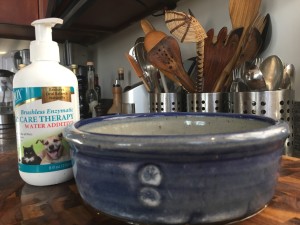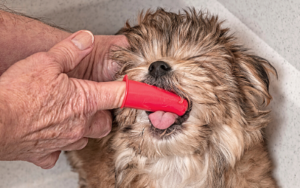Any Amount Helps
If it seems daunting to take on brushing your pet’s teeth, remember that any amount helps, it could add years to their lives, and you’ll save a lot of money. Your vet has to remove calcified plaque, but by brushing even once a week, you can help prevent calculus from forming…and that means a lot more time between vet visits. Veterinary dental cleanings are done under anesthesia, which comes with a risk, especially with short-shouted dogs. Even brushing once a month will help. Between brushings, provide chews and dental toys to help scrape and stimulate the gum line, and to minimize dry mouth (which provides an easy path for plaque to develop) and bacteria growth during the day, try water additives and breath sprays designed for oral care. Here we’ll discuss how to get started. Keep in mind that getting started is the hardest part. Keep it simple and focus on developing a routine that you can stick with and build upon.
Toothpaste
Enzymatic toothpastes are considered ‘brushless’ because the enzymes in the gel or paste, once in the mouth, will circulate in the saliva, killing bacteria and inhibiting plaque from forming on the teeth. That’s definitely a leg up. But, your eventual goal is the mechanical abrasion (scrubbing) that brushing provides. The enzymes in enzymatic toothpastes, when used consistently, will help keep the bacteria down, soothe irritated gums, and inhibit further plaque growth but they can’t remove calcified plaque all by themselves. Cats and dogs can use the same formula but probably prefer different flavors (we haven’t found a cat yet who loves peanut butter gel like dogs do). The Tropiclean Clean Teeth Gel for Cats is a great option for finicky felines because it’s sorbitol and flavor-free. For best results, use every night just before bed, at least 30 minutes after their last drink of water. You want the gel to make contact with teeth and gums and stay there overnight, rather than get rinsed or diluted with drinking water. Squeeze a stripe of gel or paste on your finger, and wipe into your pet’s mouth. The paste will circulate in the saliva, and while it stays in contact with teeth & gums overnight, the enzymes will break down bacteria and plaque biofilm. In the morning, tartar will be softened and if you then provide a raw bone, raw neck or back, dental chew or tendon that will promote movement of that softened tartar.
Water Additives
 Consider a water additive to support your routine in between brushing. Put a couple of squirts in their bowl of fresh water every day and bathe their gums and teeth in an anti-bacterial solution that kills bacteria and even breaks down plaque as they drink throughout the day. Tropiclean makes a water additive for dogs and a water additive for cats as part of their Fresh Breath Total Care line. While we don’t think water additive all by itself will support healthy teeth and gums, it’s an easy way for you to add an additional line of defense by inhibiting the growth of plaque-friendly bacteria.
Consider a water additive to support your routine in between brushing. Put a couple of squirts in their bowl of fresh water every day and bathe their gums and teeth in an anti-bacterial solution that kills bacteria and even breaks down plaque as they drink throughout the day. Tropiclean makes a water additive for dogs and a water additive for cats as part of their Fresh Breath Total Care line. While we don’t think water additive all by itself will support healthy teeth and gums, it’s an easy way for you to add an additional line of defense by inhibiting the growth of plaque-friendly bacteria.
Brushing Pets Teeth
Simple tips for brushing pets teeth: one, start young if you can…de-sensitize your pet to having their teeth and gums handled as a pup or kitten. Two, make it fun…whether with a puppy/kitten or an adult, introduce brushing gradually, and provide treats for a reward every time. Really bad breath and/or bleeding gums could mean gum disease, and you should have your vet take a look. Do use an enzymatic or flavored dog or cat toothpaste (not human, as the fluoride isn’t good for them) and/or treats. For dogs for instance, try putting a little peanut butter on the toothbrush and let him or her lick it off as a treat, working up to spreading the peanut butter or flavored toothpaste right onto the teeth with the brush, and eventually actually brushing. We recommend finger brushes…way less scary than a toothbrush, and more like a massage. DIYer’s, you can make your own finger brush by wrapping your finger in some gauze. Then dip your finger it in broth, and gently rub the teeth and gums.
Intimidated by the idea of brushing? Start simple. Get an easy to use product that doesn’t require brushing, like this brush-less berry-flavored gel, and just focus on creating the ritual of putting the gel on their teeth every night. As it circulates the mouth through the saliva it should soften tartar. Add on by providing a chew or dental toy first thing in the morning to help move any softened tartar.
 Build from there slowly….get an oral care spray and use it during the day to help inhibit bacteria growth between morning and night. Then once you and your pet have established those routines, get a brush kit with a finger brush, toothbrush and gel and start with the finger brush first, and work up to using a toothbrush with a handle. Slow and steady, give your pet and yourself plenty of time to acclimate to the life-long habit you are creating. Check out our range of products by Tropiclean for dogs and Tropiclean for cats for very easy-to-use kits, sprays, gels and water additives. For more info on how to brush your pet’s teeth, watch Dr. Karen Becker’s video on brushing teeth for cats, or read her article on Brushing Pet’s Teeth (she covers both cats and dogs).
Build from there slowly….get an oral care spray and use it during the day to help inhibit bacteria growth between morning and night. Then once you and your pet have established those routines, get a brush kit with a finger brush, toothbrush and gel and start with the finger brush first, and work up to using a toothbrush with a handle. Slow and steady, give your pet and yourself plenty of time to acclimate to the life-long habit you are creating. Check out our range of products by Tropiclean for dogs and Tropiclean for cats for very easy-to-use kits, sprays, gels and water additives. For more info on how to brush your pet’s teeth, watch Dr. Karen Becker’s video on brushing teeth for cats, or read her article on Brushing Pet’s Teeth (she covers both cats and dogs).
